Comprehensive Analysis of Quality and Safety in Healthcare Report
VerifiedAdded on 2022/08/15
|9
|2027
|27
Report
AI Summary
This report delves into the critical aspects of quality and safety within healthcare settings. It begins by defining patient safety and highlighting its importance in minimizing harm and ensuring a safe environment for patients. The report then explores risk management processes, including the use of tools like FMEA and RCA, to identify and mitigate potential risks. The concept of safety culture is examined, emphasizing its role in fostering a workplace where employees openly share concerns and contribute to improved safety policies. The report also discusses clinical governance and clinical leadership, outlining their distinct roles in maintaining and enhancing the quality of healthcare services, and stresses the importance of effective communication between healthcare professionals to ensure patient well-being and improve service quality. References from WHO, NHS, and other relevant organizations are included to support the analysis.
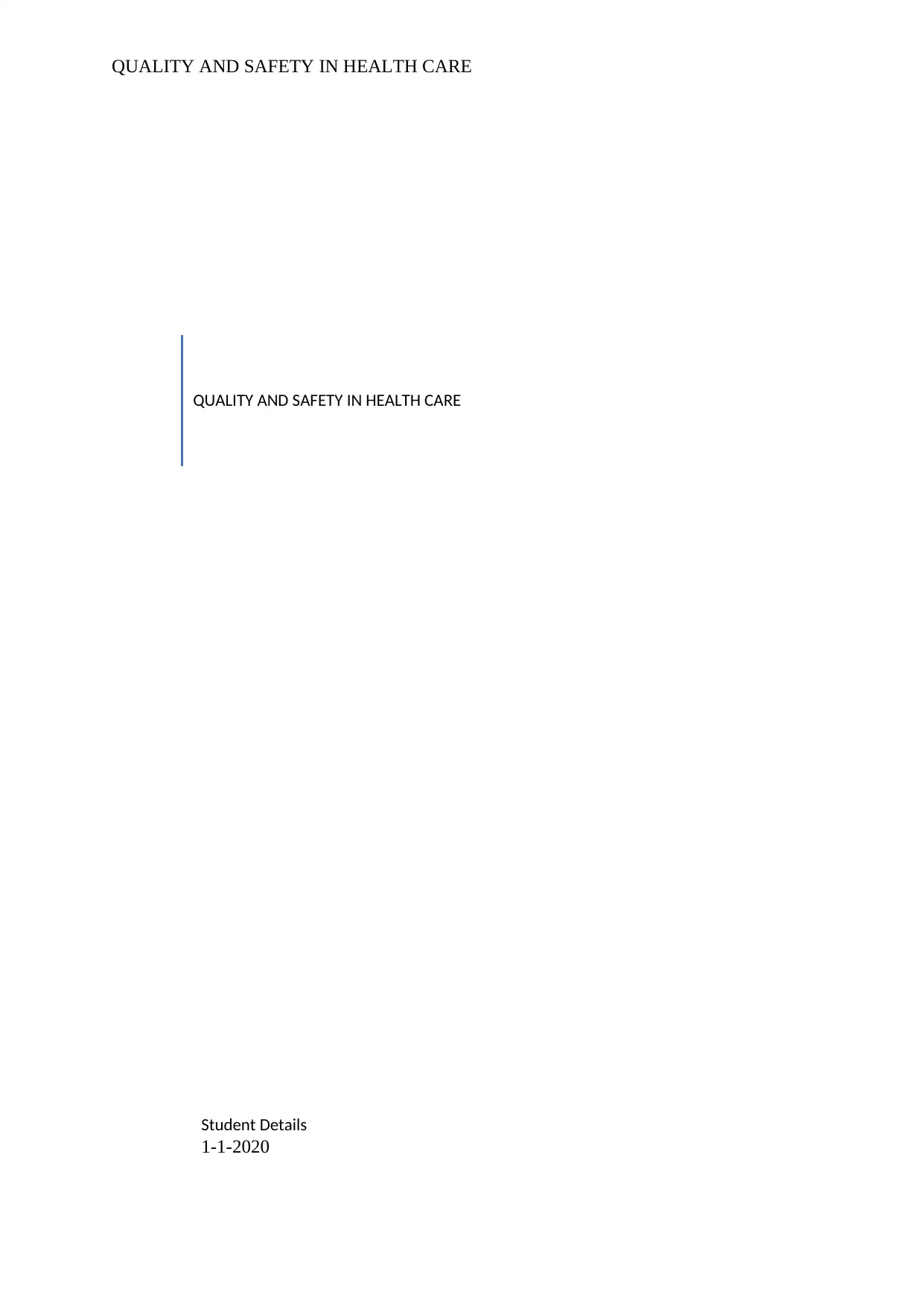
QUALITY AND SAFETY IN HEALTH CARE
QUALITY AND SAFETY IN HEALTH CARE
Student Details
1-1-2020
QUALITY AND SAFETY IN HEALTH CARE
Student Details
1-1-2020
Paraphrase This Document
Need a fresh take? Get an instant paraphrase of this document with our AI Paraphraser
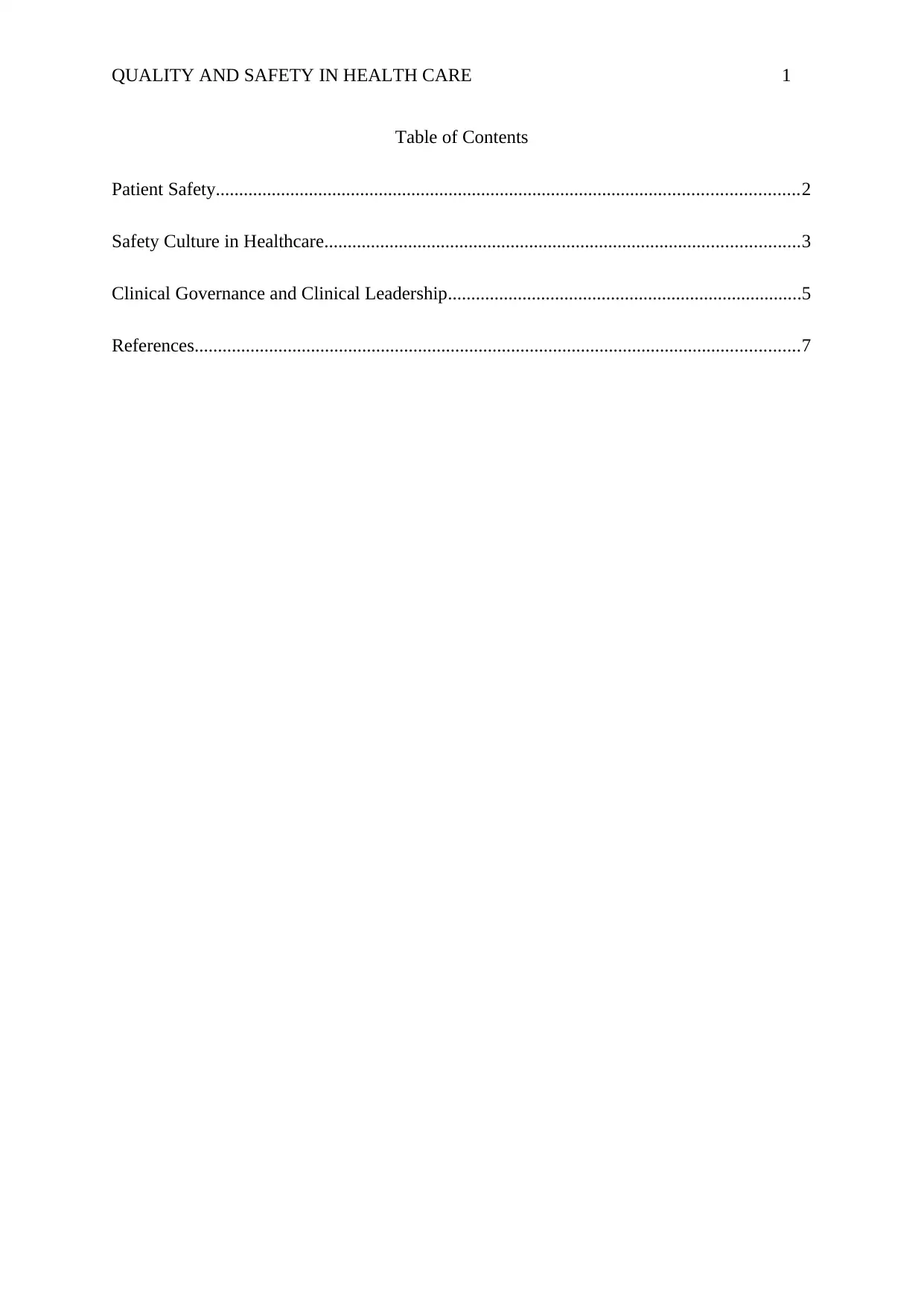
QUALITY AND SAFETY IN HEALTH CARE 1
Table of Contents
Patient Safety.............................................................................................................................2
Safety Culture in Healthcare......................................................................................................3
Clinical Governance and Clinical Leadership............................................................................5
References..................................................................................................................................7
Table of Contents
Patient Safety.............................................................................................................................2
Safety Culture in Healthcare......................................................................................................3
Clinical Governance and Clinical Leadership............................................................................5
References..................................................................................................................................7
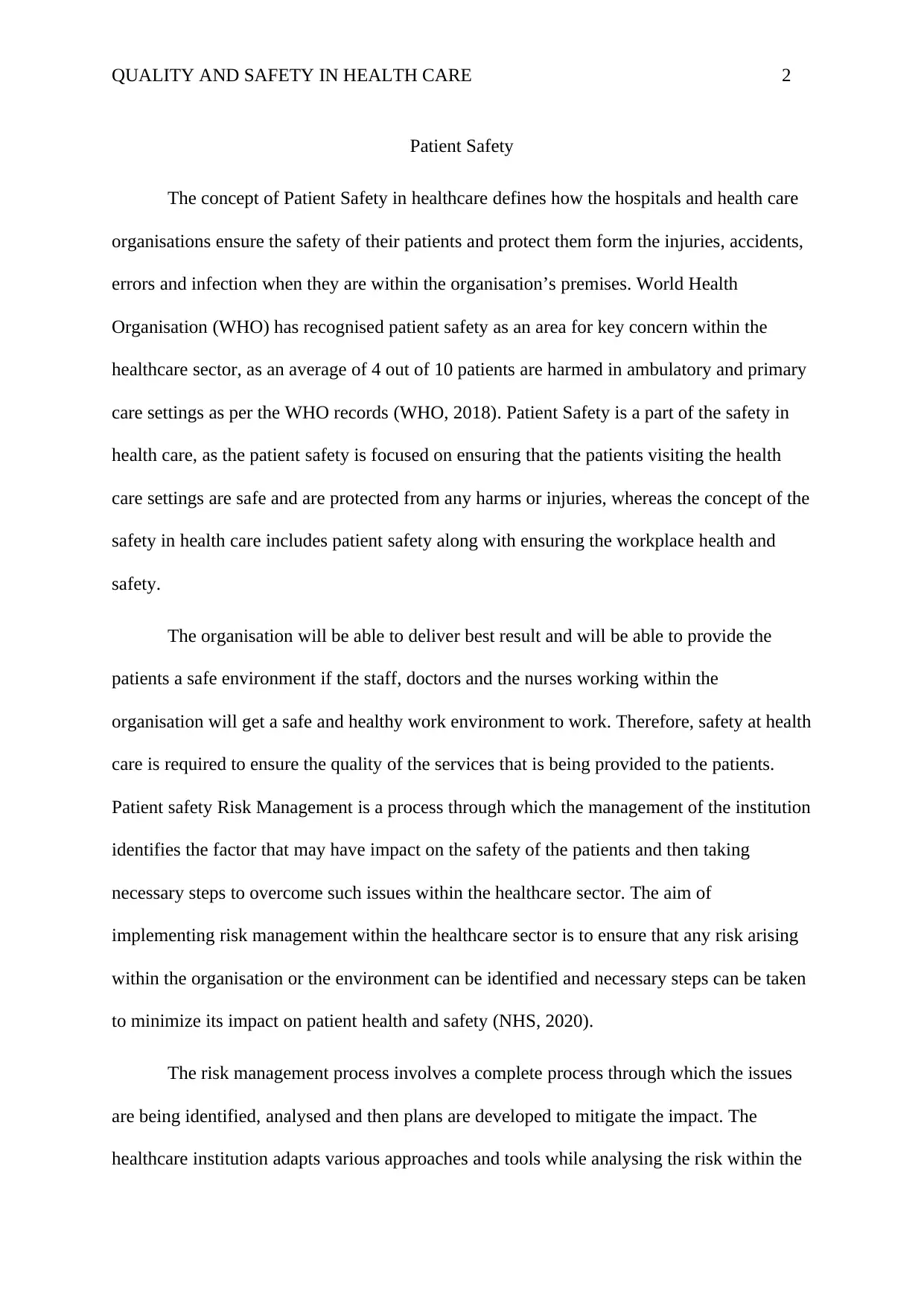
QUALITY AND SAFETY IN HEALTH CARE 2
Patient Safety
The concept of Patient Safety in healthcare defines how the hospitals and health care
organisations ensure the safety of their patients and protect them form the injuries, accidents,
errors and infection when they are within the organisation’s premises. World Health
Organisation (WHO) has recognised patient safety as an area for key concern within the
healthcare sector, as an average of 4 out of 10 patients are harmed in ambulatory and primary
care settings as per the WHO records (WHO, 2018). Patient Safety is a part of the safety in
health care, as the patient safety is focused on ensuring that the patients visiting the health
care settings are safe and are protected from any harms or injuries, whereas the concept of the
safety in health care includes patient safety along with ensuring the workplace health and
safety.
The organisation will be able to deliver best result and will be able to provide the
patients a safe environment if the staff, doctors and the nurses working within the
organisation will get a safe and healthy work environment to work. Therefore, safety at health
care is required to ensure the quality of the services that is being provided to the patients.
Patient safety Risk Management is a process through which the management of the institution
identifies the factor that may have impact on the safety of the patients and then taking
necessary steps to overcome such issues within the healthcare sector. The aim of
implementing risk management within the healthcare sector is to ensure that any risk arising
within the organisation or the environment can be identified and necessary steps can be taken
to minimize its impact on patient health and safety (NHS, 2020).
The risk management process involves a complete process through which the issues
are being identified, analysed and then plans are developed to mitigate the impact. The
healthcare institution adapts various approaches and tools while analysing the risk within the
Patient Safety
The concept of Patient Safety in healthcare defines how the hospitals and health care
organisations ensure the safety of their patients and protect them form the injuries, accidents,
errors and infection when they are within the organisation’s premises. World Health
Organisation (WHO) has recognised patient safety as an area for key concern within the
healthcare sector, as an average of 4 out of 10 patients are harmed in ambulatory and primary
care settings as per the WHO records (WHO, 2018). Patient Safety is a part of the safety in
health care, as the patient safety is focused on ensuring that the patients visiting the health
care settings are safe and are protected from any harms or injuries, whereas the concept of the
safety in health care includes patient safety along with ensuring the workplace health and
safety.
The organisation will be able to deliver best result and will be able to provide the
patients a safe environment if the staff, doctors and the nurses working within the
organisation will get a safe and healthy work environment to work. Therefore, safety at health
care is required to ensure the quality of the services that is being provided to the patients.
Patient safety Risk Management is a process through which the management of the institution
identifies the factor that may have impact on the safety of the patients and then taking
necessary steps to overcome such issues within the healthcare sector. The aim of
implementing risk management within the healthcare sector is to ensure that any risk arising
within the organisation or the environment can be identified and necessary steps can be taken
to minimize its impact on patient health and safety (NHS, 2020).
The risk management process involves a complete process through which the issues
are being identified, analysed and then plans are developed to mitigate the impact. The
healthcare institution adapts various approaches and tools while analysing the risk within the
⊘ This is a preview!⊘
Do you want full access?
Subscribe today to unlock all pages.

Trusted by 1+ million students worldwide
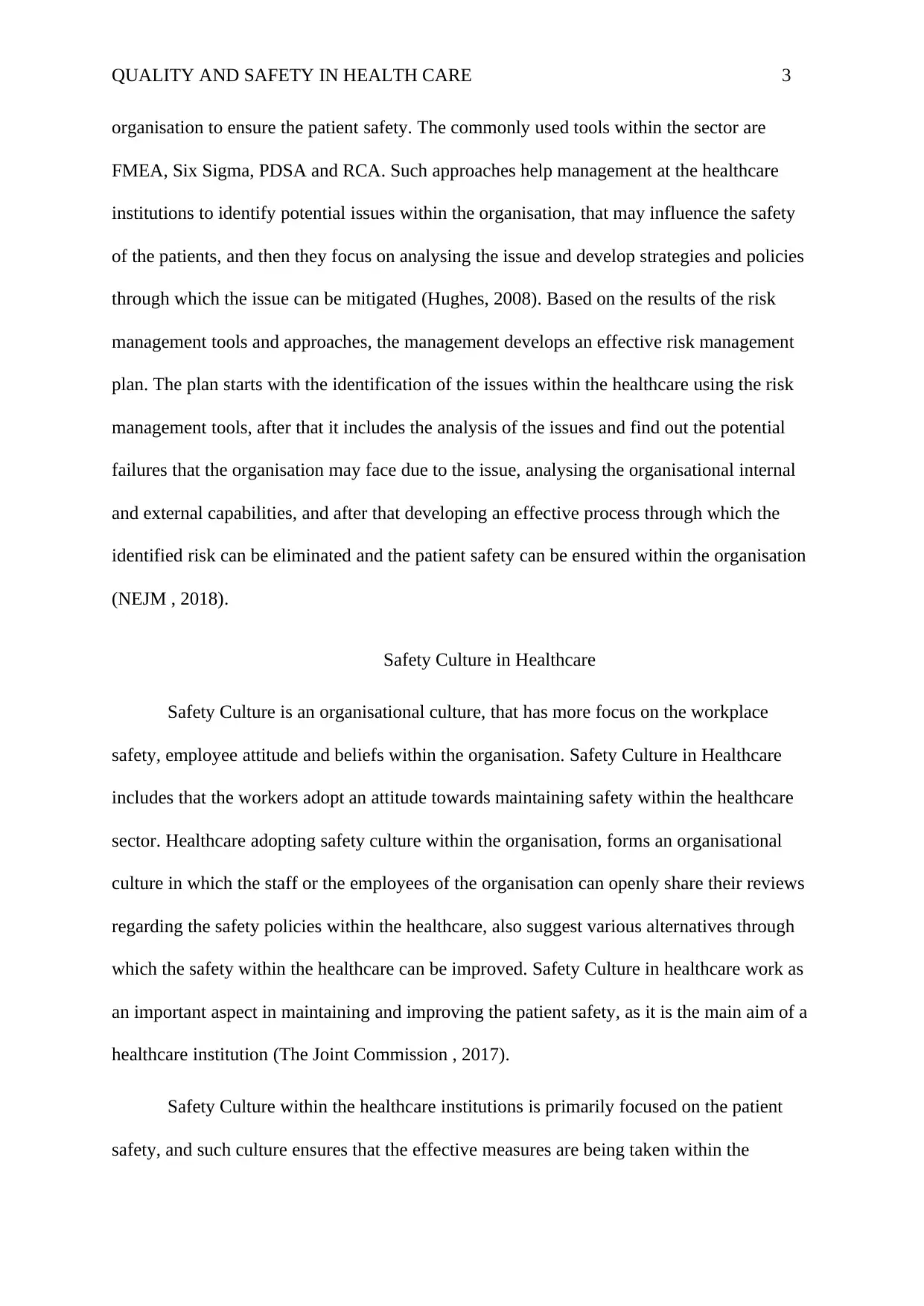
QUALITY AND SAFETY IN HEALTH CARE 3
organisation to ensure the patient safety. The commonly used tools within the sector are
FMEA, Six Sigma, PDSA and RCA. Such approaches help management at the healthcare
institutions to identify potential issues within the organisation, that may influence the safety
of the patients, and then they focus on analysing the issue and develop strategies and policies
through which the issue can be mitigated (Hughes, 2008). Based on the results of the risk
management tools and approaches, the management develops an effective risk management
plan. The plan starts with the identification of the issues within the healthcare using the risk
management tools, after that it includes the analysis of the issues and find out the potential
failures that the organisation may face due to the issue, analysing the organisational internal
and external capabilities, and after that developing an effective process through which the
identified risk can be eliminated and the patient safety can be ensured within the organisation
(NEJM , 2018).
Safety Culture in Healthcare
Safety Culture is an organisational culture, that has more focus on the workplace
safety, employee attitude and beliefs within the organisation. Safety Culture in Healthcare
includes that the workers adopt an attitude towards maintaining safety within the healthcare
sector. Healthcare adopting safety culture within the organisation, forms an organisational
culture in which the staff or the employees of the organisation can openly share their reviews
regarding the safety policies within the healthcare, also suggest various alternatives through
which the safety within the healthcare can be improved. Safety Culture in healthcare work as
an important aspect in maintaining and improving the patient safety, as it is the main aim of a
healthcare institution (The Joint Commission , 2017).
Safety Culture within the healthcare institutions is primarily focused on the patient
safety, and such culture ensures that the effective measures are being taken within the
organisation to ensure the patient safety. The commonly used tools within the sector are
FMEA, Six Sigma, PDSA and RCA. Such approaches help management at the healthcare
institutions to identify potential issues within the organisation, that may influence the safety
of the patients, and then they focus on analysing the issue and develop strategies and policies
through which the issue can be mitigated (Hughes, 2008). Based on the results of the risk
management tools and approaches, the management develops an effective risk management
plan. The plan starts with the identification of the issues within the healthcare using the risk
management tools, after that it includes the analysis of the issues and find out the potential
failures that the organisation may face due to the issue, analysing the organisational internal
and external capabilities, and after that developing an effective process through which the
identified risk can be eliminated and the patient safety can be ensured within the organisation
(NEJM , 2018).
Safety Culture in Healthcare
Safety Culture is an organisational culture, that has more focus on the workplace
safety, employee attitude and beliefs within the organisation. Safety Culture in Healthcare
includes that the workers adopt an attitude towards maintaining safety within the healthcare
sector. Healthcare adopting safety culture within the organisation, forms an organisational
culture in which the staff or the employees of the organisation can openly share their reviews
regarding the safety policies within the healthcare, also suggest various alternatives through
which the safety within the healthcare can be improved. Safety Culture in healthcare work as
an important aspect in maintaining and improving the patient safety, as it is the main aim of a
healthcare institution (The Joint Commission , 2017).
Safety Culture within the healthcare institutions is primarily focused on the patient
safety, and such culture ensures that the effective measures are being taken within the
Paraphrase This Document
Need a fresh take? Get an instant paraphrase of this document with our AI Paraphraser
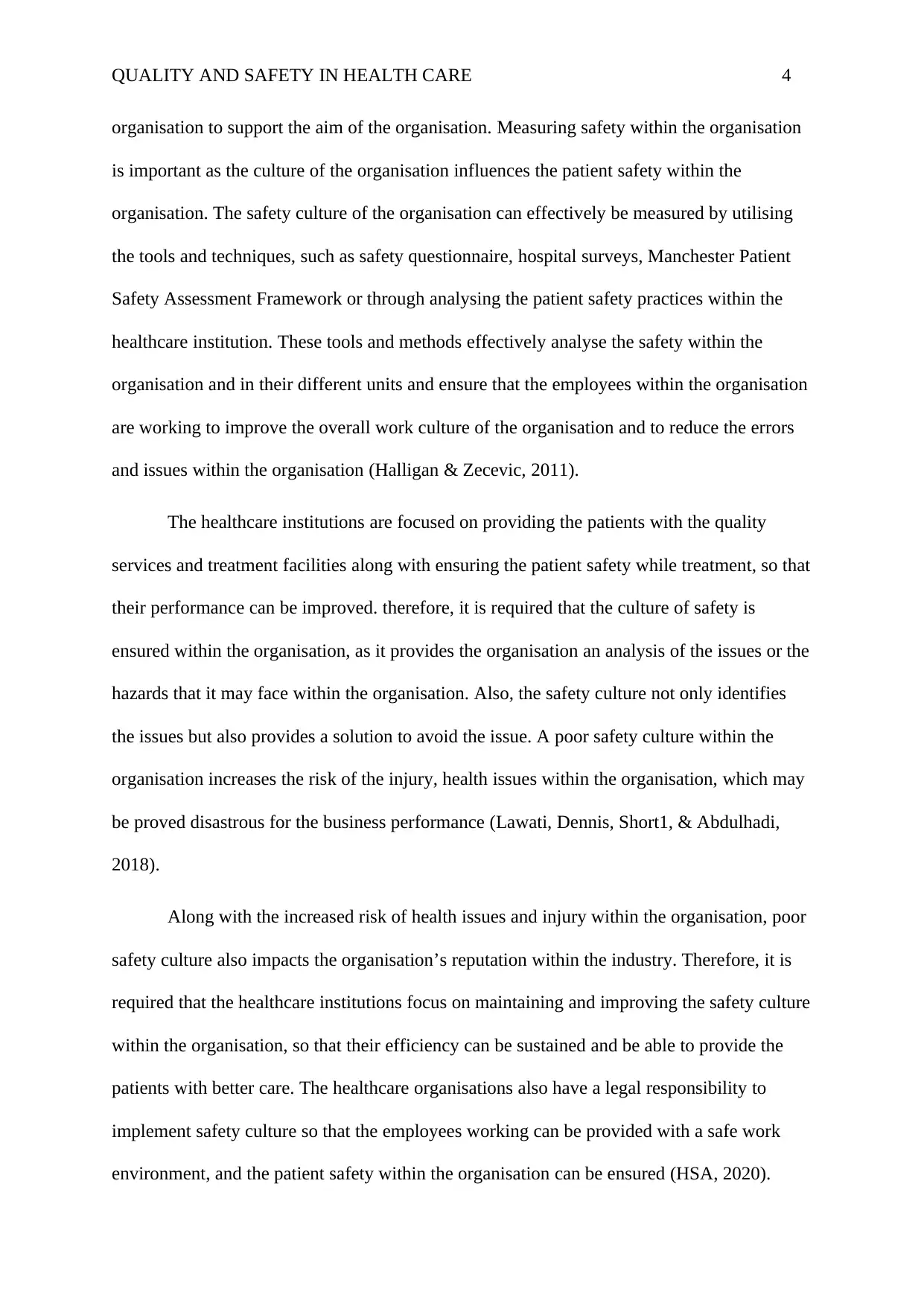
QUALITY AND SAFETY IN HEALTH CARE 4
organisation to support the aim of the organisation. Measuring safety within the organisation
is important as the culture of the organisation influences the patient safety within the
organisation. The safety culture of the organisation can effectively be measured by utilising
the tools and techniques, such as safety questionnaire, hospital surveys, Manchester Patient
Safety Assessment Framework or through analysing the patient safety practices within the
healthcare institution. These tools and methods effectively analyse the safety within the
organisation and in their different units and ensure that the employees within the organisation
are working to improve the overall work culture of the organisation and to reduce the errors
and issues within the organisation (Halligan & Zecevic, 2011).
The healthcare institutions are focused on providing the patients with the quality
services and treatment facilities along with ensuring the patient safety while treatment, so that
their performance can be improved. therefore, it is required that the culture of safety is
ensured within the organisation, as it provides the organisation an analysis of the issues or the
hazards that it may face within the organisation. Also, the safety culture not only identifies
the issues but also provides a solution to avoid the issue. A poor safety culture within the
organisation increases the risk of the injury, health issues within the organisation, which may
be proved disastrous for the business performance (Lawati, Dennis, Short1, & Abdulhadi,
2018).
Along with the increased risk of health issues and injury within the organisation, poor
safety culture also impacts the organisation’s reputation within the industry. Therefore, it is
required that the healthcare institutions focus on maintaining and improving the safety culture
within the organisation, so that their efficiency can be sustained and be able to provide the
patients with better care. The healthcare organisations also have a legal responsibility to
implement safety culture so that the employees working can be provided with a safe work
environment, and the patient safety within the organisation can be ensured (HSA, 2020).
organisation to support the aim of the organisation. Measuring safety within the organisation
is important as the culture of the organisation influences the patient safety within the
organisation. The safety culture of the organisation can effectively be measured by utilising
the tools and techniques, such as safety questionnaire, hospital surveys, Manchester Patient
Safety Assessment Framework or through analysing the patient safety practices within the
healthcare institution. These tools and methods effectively analyse the safety within the
organisation and in their different units and ensure that the employees within the organisation
are working to improve the overall work culture of the organisation and to reduce the errors
and issues within the organisation (Halligan & Zecevic, 2011).
The healthcare institutions are focused on providing the patients with the quality
services and treatment facilities along with ensuring the patient safety while treatment, so that
their performance can be improved. therefore, it is required that the culture of safety is
ensured within the organisation, as it provides the organisation an analysis of the issues or the
hazards that it may face within the organisation. Also, the safety culture not only identifies
the issues but also provides a solution to avoid the issue. A poor safety culture within the
organisation increases the risk of the injury, health issues within the organisation, which may
be proved disastrous for the business performance (Lawati, Dennis, Short1, & Abdulhadi,
2018).
Along with the increased risk of health issues and injury within the organisation, poor
safety culture also impacts the organisation’s reputation within the industry. Therefore, it is
required that the healthcare institutions focus on maintaining and improving the safety culture
within the organisation, so that their efficiency can be sustained and be able to provide the
patients with better care. The healthcare organisations also have a legal responsibility to
implement safety culture so that the employees working can be provided with a safe work
environment, and the patient safety within the organisation can be ensured (HSA, 2020).
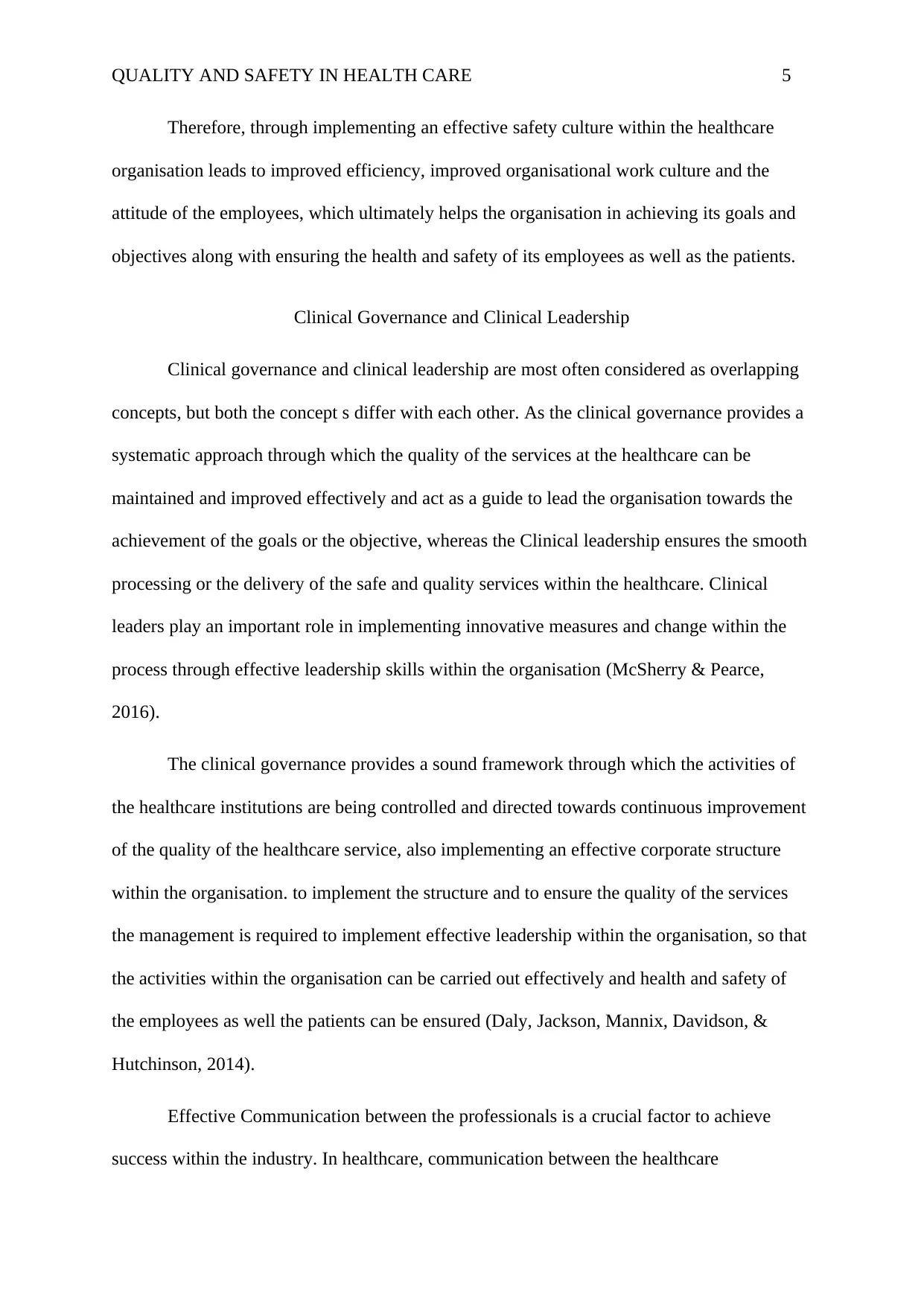
QUALITY AND SAFETY IN HEALTH CARE 5
Therefore, through implementing an effective safety culture within the healthcare
organisation leads to improved efficiency, improved organisational work culture and the
attitude of the employees, which ultimately helps the organisation in achieving its goals and
objectives along with ensuring the health and safety of its employees as well as the patients.
Clinical Governance and Clinical Leadership
Clinical governance and clinical leadership are most often considered as overlapping
concepts, but both the concept s differ with each other. As the clinical governance provides a
systematic approach through which the quality of the services at the healthcare can be
maintained and improved effectively and act as a guide to lead the organisation towards the
achievement of the goals or the objective, whereas the Clinical leadership ensures the smooth
processing or the delivery of the safe and quality services within the healthcare. Clinical
leaders play an important role in implementing innovative measures and change within the
process through effective leadership skills within the organisation (McSherry & Pearce,
2016).
The clinical governance provides a sound framework through which the activities of
the healthcare institutions are being controlled and directed towards continuous improvement
of the quality of the healthcare service, also implementing an effective corporate structure
within the organisation. to implement the structure and to ensure the quality of the services
the management is required to implement effective leadership within the organisation, so that
the activities within the organisation can be carried out effectively and health and safety of
the employees as well the patients can be ensured (Daly, Jackson, Mannix, Davidson, &
Hutchinson, 2014).
Effective Communication between the professionals is a crucial factor to achieve
success within the industry. In healthcare, communication between the healthcare
Therefore, through implementing an effective safety culture within the healthcare
organisation leads to improved efficiency, improved organisational work culture and the
attitude of the employees, which ultimately helps the organisation in achieving its goals and
objectives along with ensuring the health and safety of its employees as well as the patients.
Clinical Governance and Clinical Leadership
Clinical governance and clinical leadership are most often considered as overlapping
concepts, but both the concept s differ with each other. As the clinical governance provides a
systematic approach through which the quality of the services at the healthcare can be
maintained and improved effectively and act as a guide to lead the organisation towards the
achievement of the goals or the objective, whereas the Clinical leadership ensures the smooth
processing or the delivery of the safe and quality services within the healthcare. Clinical
leaders play an important role in implementing innovative measures and change within the
process through effective leadership skills within the organisation (McSherry & Pearce,
2016).
The clinical governance provides a sound framework through which the activities of
the healthcare institutions are being controlled and directed towards continuous improvement
of the quality of the healthcare service, also implementing an effective corporate structure
within the organisation. to implement the structure and to ensure the quality of the services
the management is required to implement effective leadership within the organisation, so that
the activities within the organisation can be carried out effectively and health and safety of
the employees as well the patients can be ensured (Daly, Jackson, Mannix, Davidson, &
Hutchinson, 2014).
Effective Communication between the professionals is a crucial factor to achieve
success within the industry. In healthcare, communication between the healthcare
⊘ This is a preview!⊘
Do you want full access?
Subscribe today to unlock all pages.

Trusted by 1+ million students worldwide
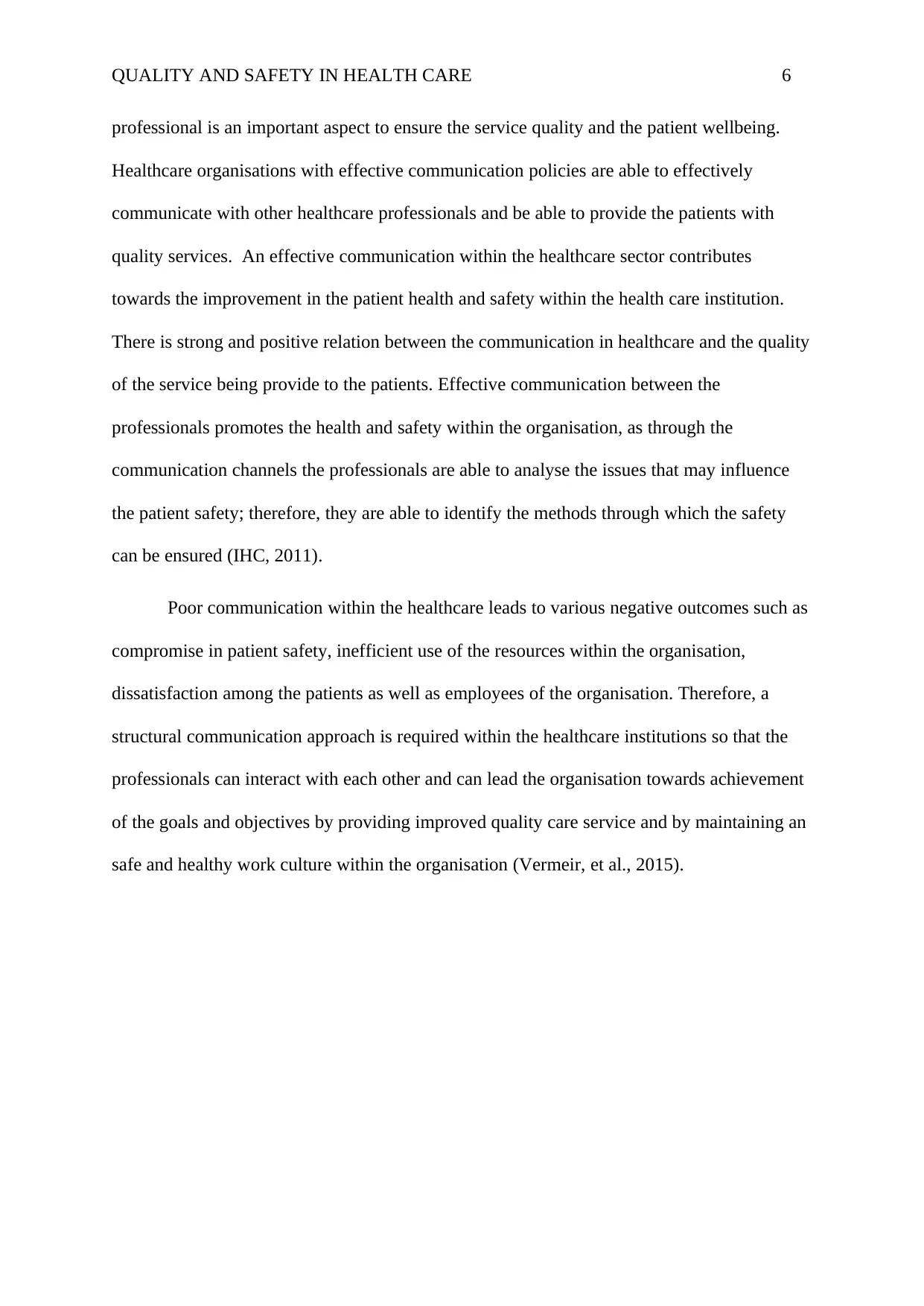
QUALITY AND SAFETY IN HEALTH CARE 6
professional is an important aspect to ensure the service quality and the patient wellbeing.
Healthcare organisations with effective communication policies are able to effectively
communicate with other healthcare professionals and be able to provide the patients with
quality services. An effective communication within the healthcare sector contributes
towards the improvement in the patient health and safety within the health care institution.
There is strong and positive relation between the communication in healthcare and the quality
of the service being provide to the patients. Effective communication between the
professionals promotes the health and safety within the organisation, as through the
communication channels the professionals are able to analyse the issues that may influence
the patient safety; therefore, they are able to identify the methods through which the safety
can be ensured (IHC, 2011).
Poor communication within the healthcare leads to various negative outcomes such as
compromise in patient safety, inefficient use of the resources within the organisation,
dissatisfaction among the patients as well as employees of the organisation. Therefore, a
structural communication approach is required within the healthcare institutions so that the
professionals can interact with each other and can lead the organisation towards achievement
of the goals and objectives by providing improved quality care service and by maintaining an
safe and healthy work culture within the organisation (Vermeir, et al., 2015).
professional is an important aspect to ensure the service quality and the patient wellbeing.
Healthcare organisations with effective communication policies are able to effectively
communicate with other healthcare professionals and be able to provide the patients with
quality services. An effective communication within the healthcare sector contributes
towards the improvement in the patient health and safety within the health care institution.
There is strong and positive relation between the communication in healthcare and the quality
of the service being provide to the patients. Effective communication between the
professionals promotes the health and safety within the organisation, as through the
communication channels the professionals are able to analyse the issues that may influence
the patient safety; therefore, they are able to identify the methods through which the safety
can be ensured (IHC, 2011).
Poor communication within the healthcare leads to various negative outcomes such as
compromise in patient safety, inefficient use of the resources within the organisation,
dissatisfaction among the patients as well as employees of the organisation. Therefore, a
structural communication approach is required within the healthcare institutions so that the
professionals can interact with each other and can lead the organisation towards achievement
of the goals and objectives by providing improved quality care service and by maintaining an
safe and healthy work culture within the organisation (Vermeir, et al., 2015).
Paraphrase This Document
Need a fresh take? Get an instant paraphrase of this document with our AI Paraphraser
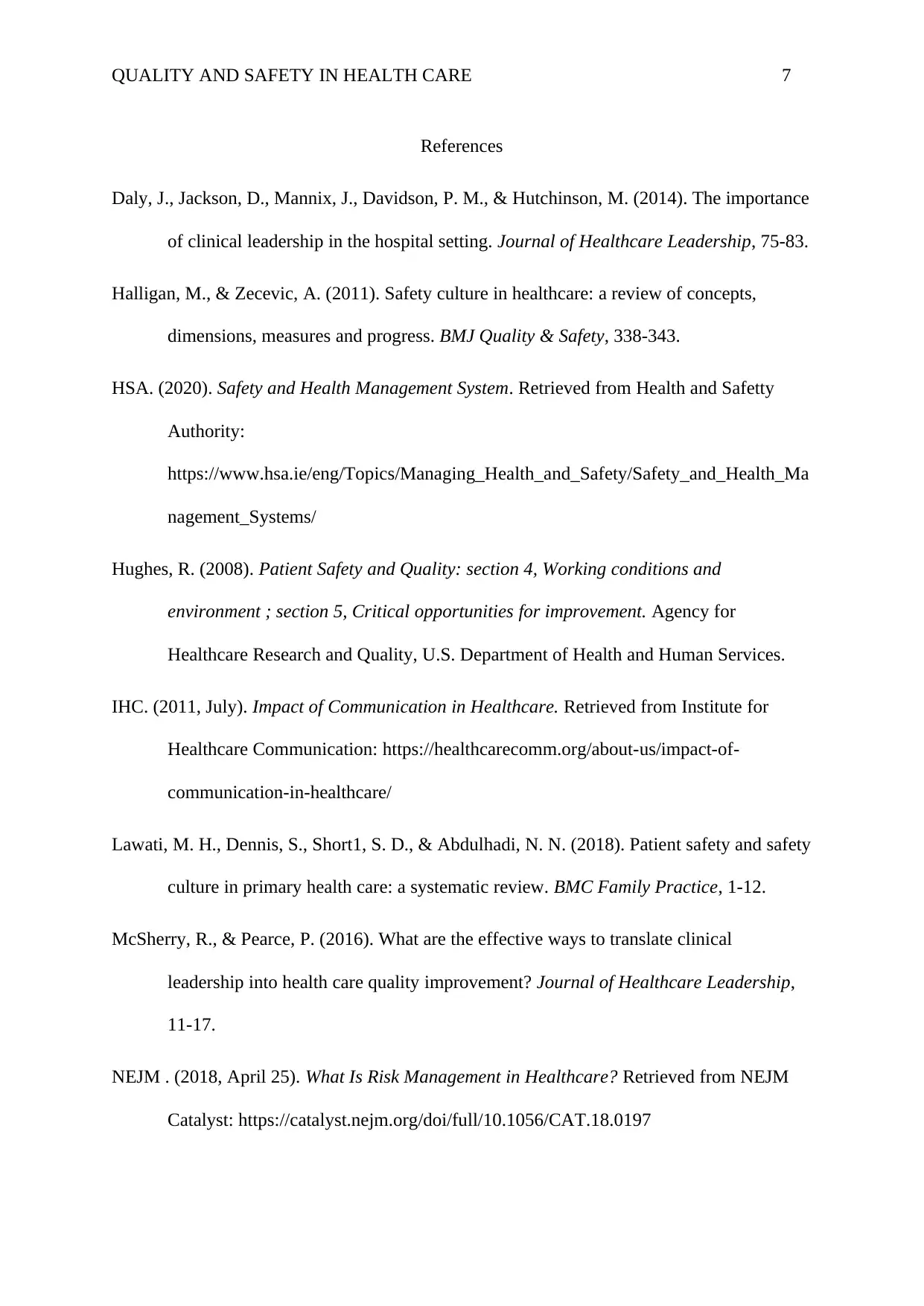
QUALITY AND SAFETY IN HEALTH CARE 7
References
Daly, J., Jackson, D., Mannix, J., Davidson, P. M., & Hutchinson, M. (2014). The importance
of clinical leadership in the hospital setting. Journal of Healthcare Leadership, 75-83.
Halligan, M., & Zecevic, A. (2011). Safety culture in healthcare: a review of concepts,
dimensions, measures and progress. BMJ Quality & Safety, 338-343.
HSA. (2020). Safety and Health Management System. Retrieved from Health and Safetty
Authority:
https://www.hsa.ie/eng/Topics/Managing_Health_and_Safety/Safety_and_Health_Ma
nagement_Systems/
Hughes, R. (2008). Patient Safety and Quality: section 4, Working conditions and
environment ; section 5, Critical opportunities for improvement. Agency for
Healthcare Research and Quality, U.S. Department of Health and Human Services.
IHC. (2011, July). Impact of Communication in Healthcare. Retrieved from Institute for
Healthcare Communication: https://healthcarecomm.org/about-us/impact-of-
communication-in-healthcare/
Lawati, M. H., Dennis, S., Short1, S. D., & Abdulhadi, N. N. (2018). Patient safety and safety
culture in primary health care: a systematic review. BMC Family Practice, 1-12.
McSherry, R., & Pearce, P. (2016). What are the effective ways to translate clinical
leadership into health care quality improvement? Journal of Healthcare Leadership,
11-17.
NEJM . (2018, April 25). What Is Risk Management in Healthcare? Retrieved from NEJM
Catalyst: https://catalyst.nejm.org/doi/full/10.1056/CAT.18.0197
References
Daly, J., Jackson, D., Mannix, J., Davidson, P. M., & Hutchinson, M. (2014). The importance
of clinical leadership in the hospital setting. Journal of Healthcare Leadership, 75-83.
Halligan, M., & Zecevic, A. (2011). Safety culture in healthcare: a review of concepts,
dimensions, measures and progress. BMJ Quality & Safety, 338-343.
HSA. (2020). Safety and Health Management System. Retrieved from Health and Safetty
Authority:
https://www.hsa.ie/eng/Topics/Managing_Health_and_Safety/Safety_and_Health_Ma
nagement_Systems/
Hughes, R. (2008). Patient Safety and Quality: section 4, Working conditions and
environment ; section 5, Critical opportunities for improvement. Agency for
Healthcare Research and Quality, U.S. Department of Health and Human Services.
IHC. (2011, July). Impact of Communication in Healthcare. Retrieved from Institute for
Healthcare Communication: https://healthcarecomm.org/about-us/impact-of-
communication-in-healthcare/
Lawati, M. H., Dennis, S., Short1, S. D., & Abdulhadi, N. N. (2018). Patient safety and safety
culture in primary health care: a systematic review. BMC Family Practice, 1-12.
McSherry, R., & Pearce, P. (2016). What are the effective ways to translate clinical
leadership into health care quality improvement? Journal of Healthcare Leadership,
11-17.
NEJM . (2018, April 25). What Is Risk Management in Healthcare? Retrieved from NEJM
Catalyst: https://catalyst.nejm.org/doi/full/10.1056/CAT.18.0197
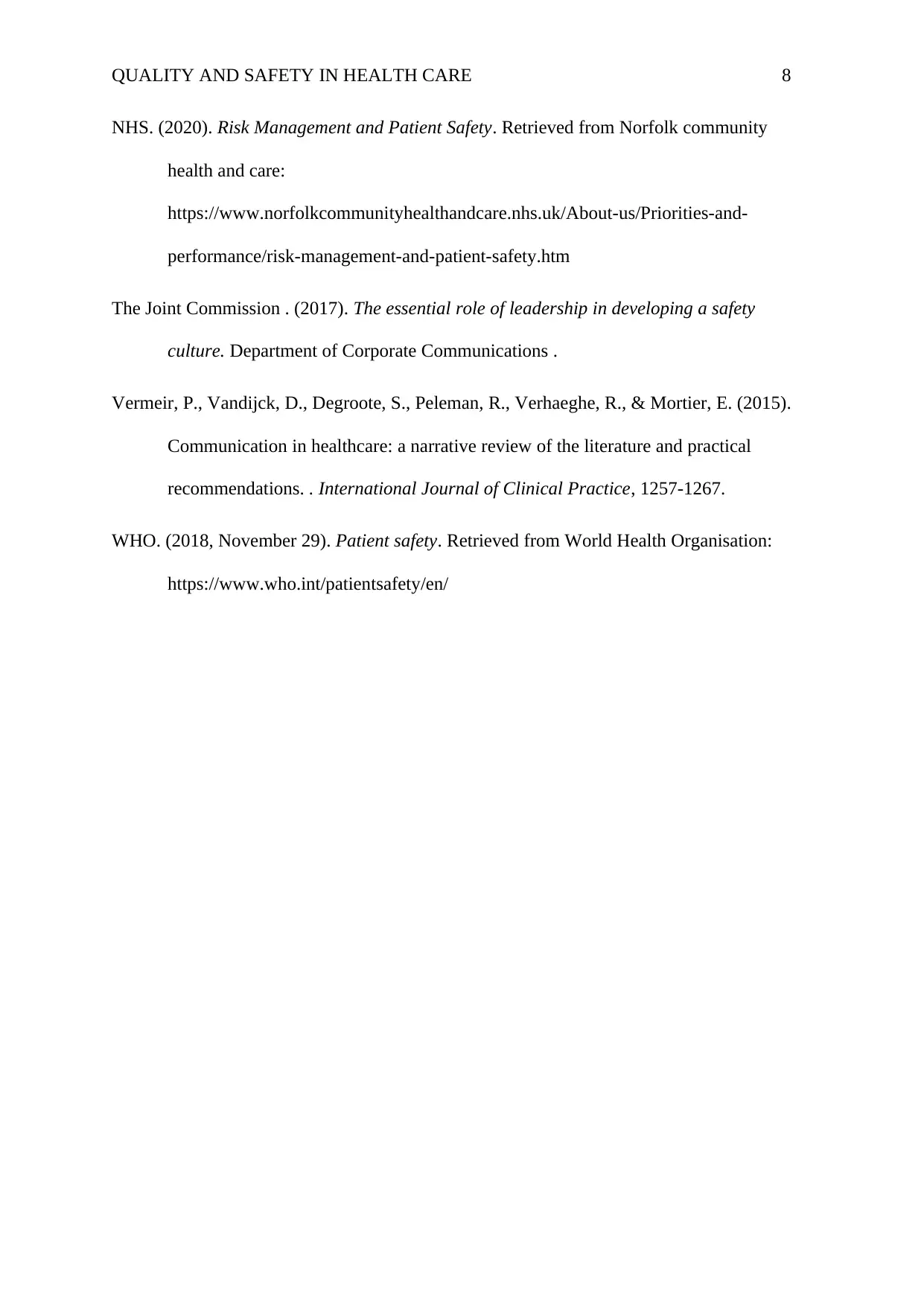
QUALITY AND SAFETY IN HEALTH CARE 8
NHS. (2020). Risk Management and Patient Safety. Retrieved from Norfolk community
health and care:
https://www.norfolkcommunityhealthandcare.nhs.uk/About-us/Priorities-and-
performance/risk-management-and-patient-safety.htm
The Joint Commission . (2017). The essential role of leadership in developing a safety
culture. Department of Corporate Communications .
Vermeir, P., Vandijck, D., Degroote, S., Peleman, R., Verhaeghe, R., & Mortier, E. (2015).
Communication in healthcare: a narrative review of the literature and practical
recommendations. . International Journal of Clinical Practice, 1257-1267.
WHO. (2018, November 29). Patient safety. Retrieved from World Health Organisation:
https://www.who.int/patientsafety/en/
NHS. (2020). Risk Management and Patient Safety. Retrieved from Norfolk community
health and care:
https://www.norfolkcommunityhealthandcare.nhs.uk/About-us/Priorities-and-
performance/risk-management-and-patient-safety.htm
The Joint Commission . (2017). The essential role of leadership in developing a safety
culture. Department of Corporate Communications .
Vermeir, P., Vandijck, D., Degroote, S., Peleman, R., Verhaeghe, R., & Mortier, E. (2015).
Communication in healthcare: a narrative review of the literature and practical
recommendations. . International Journal of Clinical Practice, 1257-1267.
WHO. (2018, November 29). Patient safety. Retrieved from World Health Organisation:
https://www.who.int/patientsafety/en/
⊘ This is a preview!⊘
Do you want full access?
Subscribe today to unlock all pages.

Trusted by 1+ million students worldwide
1 out of 9
Related Documents
Your All-in-One AI-Powered Toolkit for Academic Success.
+13062052269
info@desklib.com
Available 24*7 on WhatsApp / Email
![[object Object]](/_next/static/media/star-bottom.7253800d.svg)
Unlock your academic potential
Copyright © 2020–2025 A2Z Services. All Rights Reserved. Developed and managed by ZUCOL.





